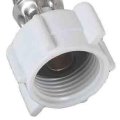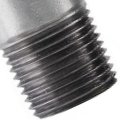Home Plumbing Connector Types
Fitting Examples
7/8" Ballcock Toilet Connector
 Also called: 7/8 in. Ballcock Nut. Screws on to bottom of toilet tank. Slightly smaller than standard 1/2" pipe thread. Typically on a braid water connector that is 3/8" compression on the opposite end. A Toilet Ballcock Assembly is the entire upright part inside the toilet tank with with valve plunger on top and screw connector that sticks out though the hole in the bottom of the tank.
Also called: 7/8 in. Ballcock Nut. Screws on to bottom of toilet tank. Slightly smaller than standard 1/2" pipe thread. Typically on a braid water connector that is 3/8" compression on the opposite end. A Toilet Ballcock Assembly is the entire upright part inside the toilet tank with with valve plunger on top and screw connector that sticks out though the hole in the bottom of the tank.
Common fittings:
- 3/8 Compression X 7/8 Ballcock 9"
- Plastic Toilet Swivel Adapter, 1/2" PEX x 7/8" BallCock
1/2" Pipe Thread
 Also called: 1/2" NTP. National Pipe Thread Tapered Thread. This type of pipe thread is tapered so that the fit tightens as the pipe is twisted in. Common residential NTP pipe use is for water and natural gas. Although galvanized (zinc-coated) pipe is still considered to be a safe transport material for drinking water, there are some potential health concerns because this type of pipe tends to corrode over years of use.
Also called: 1/2" NTP. National Pipe Thread Tapered Thread. This type of pipe thread is tapered so that the fit tightens as the pipe is twisted in. Common residential NTP pipe use is for water and natural gas. Although galvanized (zinc-coated) pipe is still considered to be a safe transport material for drinking water, there are some potential health concerns because this type of pipe tends to corrode over years of use.
American Tapered Pipe Threads NTP
Two of the more popular thread forms used are the Dryseal American Standard Taper Pipe Thread (NPTF) and American Standard Straight Pipe Thread for Mechanical Joints (NPSM). Pipe thread sizes are described much as bolt sizes are. Pipe threads must make a mechanical joint and leakproof connection. To accomplish this, the threads become shallower the farther they are from the end of the pipe. The bottoms of the threads aren't on a cylinder, but a cone. The cone taper is 1/16" in 1", which is the same as 3/4" inch in 1'. American Standard Taper Pipe Threads (NPT) is defined by ANSI/ASME standard B1.20.1.
Galvanized Steel Pipe
Galvanized pipe is steel pipe covered with a protective coating of zinc which greatly reduces its tendency to corrode and extends its life expectancy. Public water supplies treat their water to make it essentially non-corrosive. However, plumbers will tell you that when they remove galvanized pipe, it is typically internally full of corrosion. Galvanized pipe is no longer commonly installed in residential water systems. Galvanized pipe was used extensively as water supply lines in new construction prior to the 1960's.
Calcium buildup and oxidation occur internally, causing a loss of water pressure as the opening inside the pipe decreases. A moderate level of calcium helps form a protective coating on the pipe, which may slow down corrosive effects. Even so, the pipe still corrodes over time, and fills with rust. Over time, the pipes might corrode to the point where the pipes are completely restricted due to rust. If the water system has been shut off for a period of time, such as between home owners, this can accelerate the level of corrosion internally, causing the pipe to rust from the inside out, and even leak when pressure is reintroduced.
Galvanized steel can last roughly forty years until it needs to be replaced. Hard water in the home generally reduces the life expectancy of galvanized pipe.